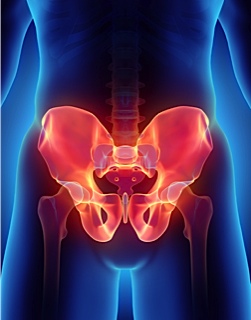Blogs / THE PELVIC “FLAW”

Once upon a time, we walked on all fours and had few problems with
incontinence, prolapses, pelvic and lower back pain.
The pelvic “floor” is an appropriate name - it is a series of muscles which lie
horizontally between the two sit bones at the side, the pubic bone at the front
and the coccyx at the back of the pelvis - and closes off the openings which
would otherwise allow the pelvic and abdominal contents above to fall
through. Indeed, it is the only horizontal load-bearing muscle group in the
body.
No wonder 1 in 3 women and 1 in 10 men suffer from incontinence!
We were just not built to withstand the weight of our upper body on a gravity
loaded, horizontal “floor”!
What is incontinence?
According to the dictionary, it is “relating to or exhibiting involuntary urination
or defecation.” In other words, the pelvic floor has a weakness and allows
involuntary passing of urine and anal waste, along with wind and in severe
cases prolapses can occur.
There are 4 types of incontinence:
1. Stress incontinence - when urine leaks from the bladder when the
abdomen and pelvic floor are under stress, such as coughing, laughing,
sneezing, jumping, running etc...
2. Urge incontinence - the leakage of urine associated with a desire or
urgency to urinate which can not be suppressed ie wetting yourself just
before reaching the bathroom.
3. Overflow incontinence - difficulty passing urine which causes the bladder to
be permanently full. As the kidneys continue to produce urine the overspill
goes into the urethra, like a dam that’s overflowing.
4. Total incontinence - a continuous leakage of urine caused by an abnormal
communication between the bladder and the vagina.
The impact of incontinence on our modern society is huge.
It costs the NHS £117 m per year and is the second reason for the elderly to
be admitted into residential care.
According to research, 27% of sufferers were unwilling to go to places where
access to toilets was restricted, 31% dressed differently, 23% said it affected
their sex life and the same percentage avoided physical activity.
The consequences of the above leads to social isolation and in the elderly, an
increased risk of falls, not to mention the huge bill for incontinence pads!
Who is at risk?
Modifiable causes include poor posture, inactivity, seated occupation, obesity,
lower back pain, pelvic instability, muscle imbalances and function, exercises
and sport which include heavy lifting and breath-holding, piriformis syndrome
and weak gluteals. Constipation, along with diet and good hydration can also
be changed.
Unmodifiable causes include age (men & women), menopause, pregnancy
and childbirth, coughing, prostate problems, surgery (men & women), IBS,
medications, illness (MS/Parkinson’s/Stroke), bladder/bowel prolapse,
infections, fibroids and hypermobility.
For many people with incontinence, the following self-help tips are useful:
1. Do daily pelvic floor exercises.*
2. Quit smoking.
3. Do the right exercises by avoiding high-impact sports and replace them
with low-impact exercises such as cycling, swimming, Yoga & Pilates.
4. Avoid lifting heavy objects. If this is not possible get help to find the correct
technique for “bracing” the pelvic floor before lifting.
5. Lose weight if you have a waist circumference > 80cm (women) and
>94cm (men)
6. Treat constipation.
7. Cut down on caffeine and alcohol.
8. Drink 2 litres of water per day.
9. Eat smart - avoid spicy & acidic foods such as curries and citrus fruits
which can irritate the bladder.
* So, I hear you asking yourself - how do I go about doing “daily pelvic floor
exercises.” ?
Part 2 of this article will explore pelvic floor exercises which we can all benefit
from, regardless of incontinence issues.
